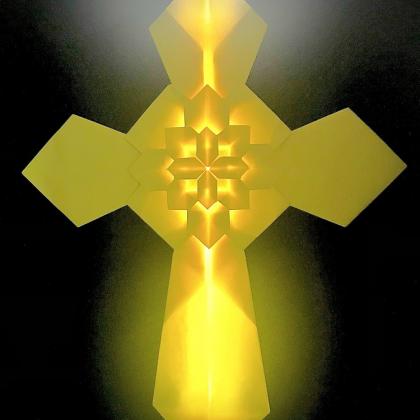As the name suggests, this piece is a cross with the Hydrangea tessellation designed by Shuzo Fujimoto.
Despite this model may seem to be complex by looking at its crease pattern, following a sequence of folds can make the whole process easier to collapse and more satisfying, making it more achievable to fold. In fact, this model starts off with the traditional bird base and does not require any precreasing before collapsing at all. This model also utilities hydrangea tessellation in the center of the paper.
Folding techniques like sinks, unsink, wrap, and tessellations are used to create the whole outline of the cross and also make the transition between 22.5 to grid for the inner tessellation. Viewing from the back side, this model is fully closed, and the use of closed sinks allows everything to be held in place and locks the tessellation tightly. Arranging layer order also allows the back side to be locked without glue.
Overall, a repetitive folding sequence, but fun simultaneously.
Despite this model may seem to be complex by looking at its crease pattern, following a sequence of folds can make the whole process easier to collapse and more satisfying, making it more achievable to fold. In fact, this model starts off with the traditional bird base and does not require any precreasing before collapsing at all. This model also utilities hydrangea tessellation in the center of the paper.
Folding techniques like sinks, unsink, wrap, and tessellations are used to create the whole outline of the cross and also make the transition between 22.5 to grid for the inner tessellation. Viewing from the back side, this model is fully closed, and the use of closed sinks allows everything to be held in place and locks the tessellation tightly. Arranging layer order also allows the back side to be locked without glue.
Overall, a repetitive folding sequence, but fun simultaneously.
Creator:
Bobby Lui
Category:
Abstract
Type:
Folding-Process
Creation Date:
